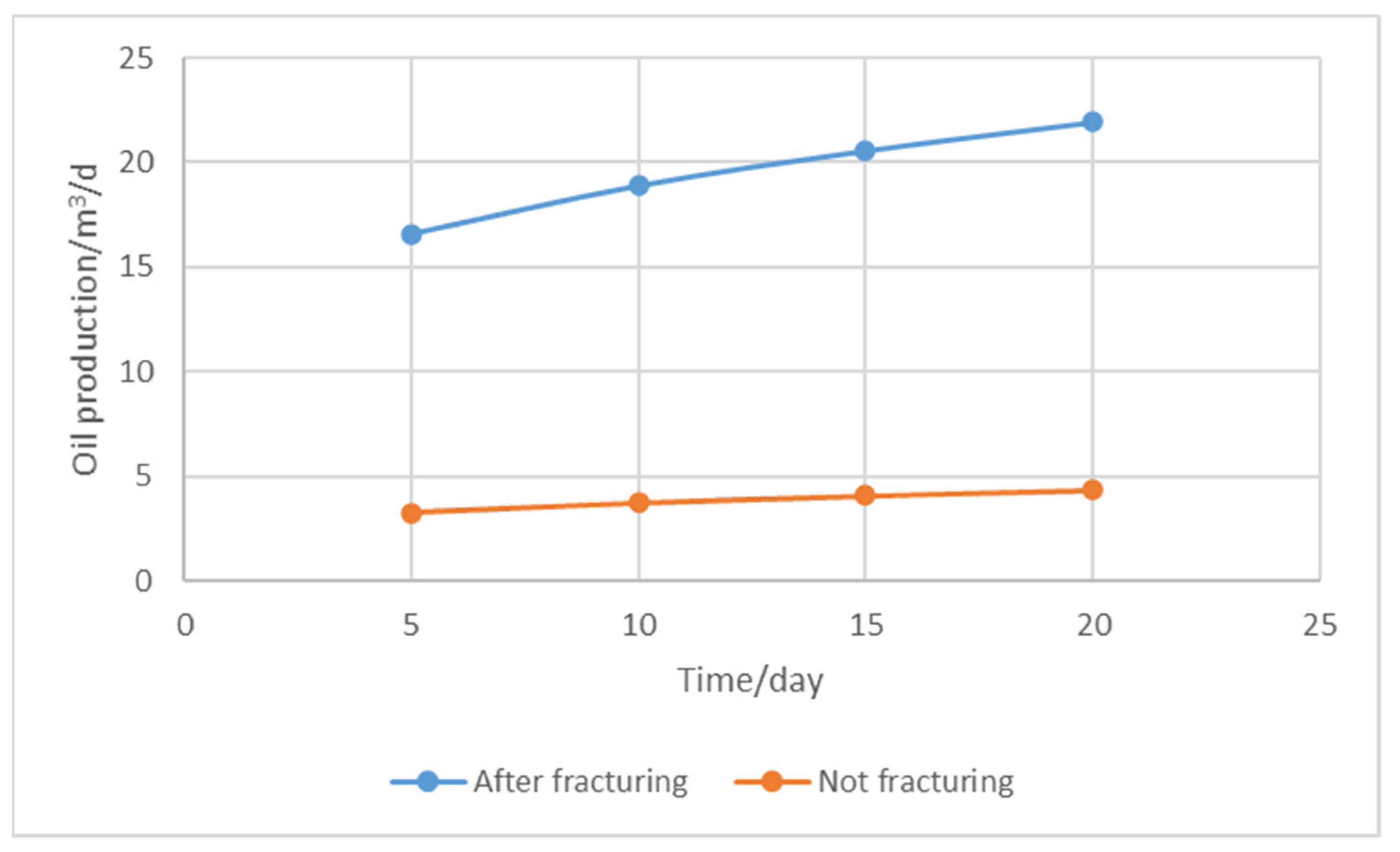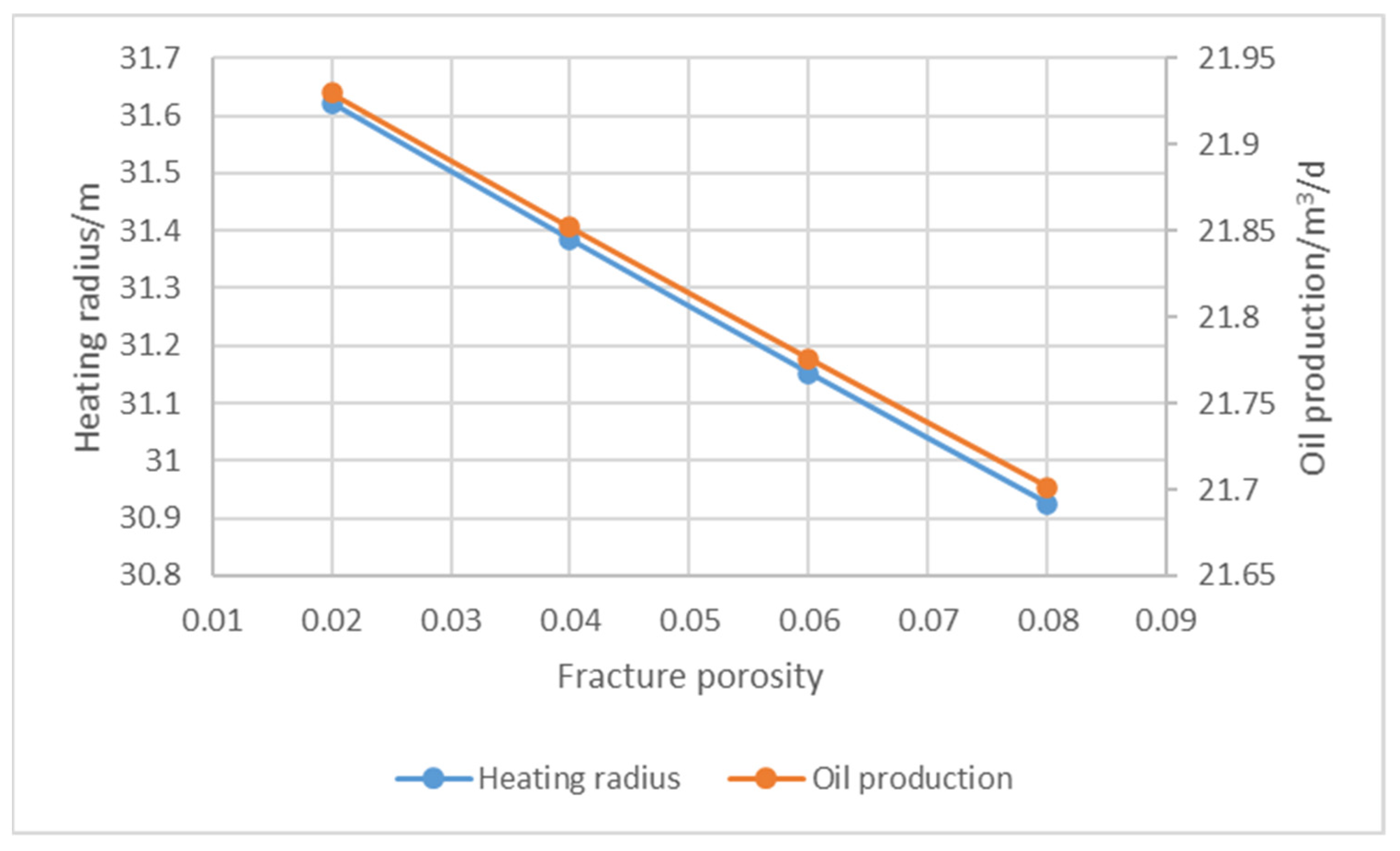Production Calculation Model of Thermal Recovery after Hydraulic Fracturing and Packing in Tight Reservoir
Abstract
:1. Introduction
2. Model Establishment
- (1)
- The temperature in the heated zone is the steam temperature.
- (2)
- During steam injection, steam injection speed and pressure remain constant.
- (3)
- Since the effect of heat conduction is much greater than that of convection, the model only considers heat conduction and does not consider the heat exchange generated by convection.
- (4)
- Some of the heat brought in by steam injection is applied to heat the matrix and fracture system, while the rest is lost in the top and bottom layers.
2.1. Heating Radius
2.1.1. Fractured Zone
2.1.2. Unfractured Zone
2.2. Productivity Calculation
3. Results and Discussions
3.1. The Heating Radius versus Time
3.2. Thermal Recovery Yield
4. Conclusions
- (1)
- After fracturing and packing, the heating radius of the heated reservoir volume is smaller than that of the unfractured reservoir, and the additional heat absorption of the fracture system generated by fracturing and packing leads to the reduction of the thermal recovery effect.
- (2)
- Fracturing can effectively improve reservoir permeability and increase production in contrast with no fracturing treatments.
- (3)
- The thermal production capacity of fractured heavy oil reservoirs is mainly affected by the heating effect, namely the heating radius. With the increase of fracture density, the heating radius decreases and the production decreases. The increase of fracture porosity also leads to the decrease of the heating radius and the production.
Author Contributions
Funding
Institutional Review Board Statement
Informed Consent Statement
Data Availability Statement
Acknowledgments
Conflicts of Interest
References
- Cil, M.; Reis, J.C.; Miller, M.A.; Misra, D. An Examination of Countercurrent Capillary Imbibition Recovery from Single Matrix Blocks and Recovery Predictions by Analytical Matrix/Fracture Transfer Functions. In Proceedings of the SPE Annual Technical Conference and Exhibition, New Orleans, LA, USA, 27–30 September 1998; p. 49005. [Google Scholar]
- Dutra, T.V.; Aziz, K. A New Double-Porosity Reservoir Model for Oil/Water Flow Problems. SPE Reserv. Eng. 1992, 7, 419–425. [Google Scholar] [CrossRef]
- Mousavi, S.M.; Masoudi, R.; Ataei, A. Evaluation of Steam Flooding and Cyclic Steam Stimulation (CSS) for a Fractured Carbonate Heavy Oil Reservoir. In Proceedings of the IPTC 15454, International Petroleum Technology Conference, Bangkok, Thailand, 7–9 February 2012. [Google Scholar]
- Hao, L. Research on Reasonable Technology Policy of Steam Huff and Puff in Fractured Heavy Oil Reservoir. Graduation Thesis, China University of Geosciences, Beijing, China, 2015. [Google Scholar]
- Mohammadi, S.; Ehsani, M.R.; Nikookar, M.; Sahranavard, L.; Garakani, A.S. Study of steam injection in a fractured carbonate heavy oil reservoir in Iran. In Proceedings of the SPE Heavy Oil Conference Canada, Calgary, AB, Canada, 12–14 June 2012; p. 144943. [Google Scholar]
- Van Heel, A.P.; van Dorp, J.J.; Boerrigter, P.M. Heavy-oil recovery by steam injection in fractured reservoirs. In Proceedings of the SPE Symposium on Improved Oil Recovery, Tulsa, OK, USA, 19–23 April 2008; p. 113461. [Google Scholar]
- Marx, J.W.; Langenheim, R.H. Reservoir heating by hot fluid injection petroleum transactions. Trans. AIME 1959, 216, 312–315. [Google Scholar] [CrossRef]
- Carslaw, H.S.; Jaeger, J.C.; Ingersoll, L.R.; Zobel, O.J.; Ingersoll, A.C.; Van Vleck, J.H. Conduction of Heat in Solids and Heat Conduction. Phys. Today 1948, 1, 24. [Google Scholar] [CrossRef]
- Boberg, T.C. Calcalation of the Production Rate of a Thermally Stimulated Well. J. Pet. Technol. 1966, 18, 1613–1623. [Google Scholar] [CrossRef]
- Gontijo, J.E.; Aziz, K. A Simple Analytical Model for Simulating Heavy Oil Recovery by Cyclic Steam in Pressure-Depleted Reservoirs. Texas. In Proceedings of the SPE Annual Technical Conference and Exhibition, Houston, TX, USA, 16–19 September 1984; p. 13037. [Google Scholar]
- Wenzhang, L. Heavy Oil Steam Injection Thermal Recovery Engineering; Beijing Petroleum Industry Press: Beijing, China, 1997; pp. 107–124. [Google Scholar]
- Jianguo, W.; Yueming, C. A new model for predicting steam throughput. Pet. Explor. Dev. 1997, 24, 53–56. [Google Scholar]





| Reservoir Pressure/MPa | Bottomhole Flowing Pressure/MPa | Thermal Conductivity of Overburden and Underlying/ | Thermal Conductivity of rock/ | Fracture Porosity | Matrix Porosity | Heat Capacity of Overburden and Underlying/ |
| 20 | 12 | 145.7 | 149.5 | 0.02 | 0.2 | 2400 |
| Heat Capacity of Rock/ | Volumetric Heat Capacity of Oil/ | Volumetric Heat Capacity of Water/ | Pay Zone Thickness/m | Initial Reservoir Temperature/°C | Gas Injection Rate/kg/h | Thermal Conductivity of Oil/ |
| 2320 | 1900 | 4200 | 20 | 60 | 6000 | 10 |
| Thermal Conductivity of Water/ | Matrix Permeability/ | Fracture Permeability/ | Oil Saturation | Water Saturation | Steam Injection Temperature/°C | |
| 50 | 0.02 | 16.7 | 0.6 | 0.6 | 300 |
Publisher’s Note: MDPI stays neutral with regard to jurisdictional claims in published maps and institutional affiliations. |
© 2021 by the authors. Licensee MDPI, Basel, Switzerland. This article is an open access article distributed under the terms and conditions of the Creative Commons Attribution (CC BY) license (https://creativecommons.org/licenses/by/4.0/).
Share and Cite
Wang, L.; Li, Y.; Li, Z.; Liu, Y.; Song, L.; Lv, Y. Production Calculation Model of Thermal Recovery after Hydraulic Fracturing and Packing in Tight Reservoir. Processes 2021, 9, 2226. https://doi.org/10.3390/pr9122226
Wang L, Li Y, Li Z, Liu Y, Song L, Lv Y. Production Calculation Model of Thermal Recovery after Hydraulic Fracturing and Packing in Tight Reservoir. Processes. 2021; 9(12):2226. https://doi.org/10.3390/pr9122226
Chicago/Turabian StyleWang, Long, Yang Li, Zhandong Li, Yikun Liu, Laiming Song, and Yunshu Lv. 2021. "Production Calculation Model of Thermal Recovery after Hydraulic Fracturing and Packing in Tight Reservoir" Processes 9, no. 12: 2226. https://doi.org/10.3390/pr9122226






